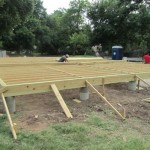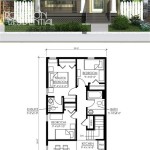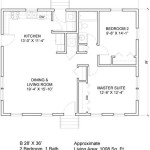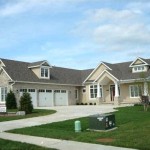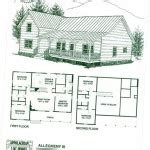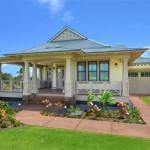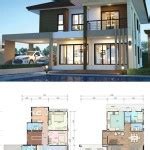Dogtrot House Plans refer to architectural blueprints designed for constructing a unique type of dwelling characterized by a central breezeway separating two enclosed sections of the house. These plans provide a practical and functional way to create a home with natural ventilation and ample living space.
Dogtrot houses originated in the rural areas of the southeastern United States, particularly in the Appalachian region, during the 18th and 19th centuries. They were known for their simplicity and adaptability to the hot and humid climate. The breezeway, or “dogtrot,” served as an open-air corridor that allowed air to circulate through the house, keeping it cool during the summer months.
In the following sections of this article, we will delve deeper into the unique features and benefits of dogtrot house plans. We will explore their historical roots, design principles, and modern interpretations. Additionally, we will provide practical considerations for those interested in constructing or renovating a dogtrot house, including floor plans, construction materials, and energy efficiency.
Dogtrot house plans offer a unique blend of historical charm and practical functionality. Here are 9 key points to consider about these plans:
- Central breezeway for ventilation
- Two separate enclosed sections
- Originated in the southeastern US
- Simple and adaptable design
- Energy-efficient in hot climates
- Wide front porches for outdoor living
- Often feature symmetrical facades
- Modern interpretations include updated materials
- Suitable for both rural and suburban settings
Dogtrot house plans continue to inspire architects and homeowners alike, offering a timeless and versatile design that embraces both tradition and contemporary living.
Central breezeway for ventilation
The central breezeway is the defining feature of a dogtrot house plan. It is an open-air corridor that runs through the center of the house, separating the two enclosed sections. The breezeway serves several important functions:
Ventilation: The primary purpose of the breezeway is to provide natural ventilation. In hot and humid climates, the breezeway allows air to circulate freely through the house, keeping it cool and comfortable. The open design of the breezeway creates a natural airflow that draws cool air in from the outside and expels hot air from the inside. This passive cooling system can significantly reduce the need for air conditioning, resulting in lower energy costs.
Natural light: The breezeway also allows natural light to penetrate deep into the house. The open design of the breezeway creates aand airy atmosphere, reducing the need for artificial lighting. The natural light can also help to improve the mood and well-being of occupants.
Outdoor living space: The breezeway can also be used as an outdoor living space. It is a great place to relax, entertain guests, or simply enjoy the fresh air. The breezeway can be furnished with chairs, a table, or even a swing, creating a comfortable and inviting space.
The central breezeway is an essential element of a dogtrot house plan. It provides natural ventilation, natural light, and outdoor living space, making it a comfortable and sustainable home.
Two separate enclosed sections
Dogtrot house plans feature two separate enclosed sections, typically referred to as the “main house” and the “kitchen ell.” These two sections are connected by the central breezeway.
Main house: The main house typically contains the bedrooms, living room, and dining room. It is usually the larger of the two sections and may also include a bathroom and utility room. The main house is designed to be a comfortable and private space for the family.
Kitchen ell: The kitchen ell is typically smaller than the main house and contains the kitchen, pantry, and sometimes a breakfast nook. It may also include a laundry room or mudroom. The kitchen ell is designed to be a functional and efficient space for preparing and eating meals.
The separation of the main house and kitchen ell has several advantages. First, it helps to keep the cooking smells and heat out of the main living areas. Second, it provides a dedicated space for food preparation and storage. Third, it allows for a more flexible floor plan, as the two sections can be arranged in different ways to suit the needs of the family.
In modern dogtrot house plans, the separation of the main house and kitchen ell is often less pronounced. The two sections may be connected by a larger breezeway or even a closed-in hallway. This allows for more open and flowing floor plans, while still maintaining the benefits of the traditional dogtrot design.
Originated in the southeastern US
Dogtrot house plans originated in the southeastern United States, particularly in the Appalachian region, during the 18th and 19th centuries. There are several reasons why this type of house became popular in this region:
Climate: The southeastern US has a hot and humid climate, with long, hot summers and mild winters. The dogtrot design was well-suited to this climate, as the open breezeway allowed for natural ventilation and cooling. The breezeway also helped to keep the house dry during the rainy season.
Building materials: The southeastern US was heavily forested, and wood was the most readily available building material. Dogtrot houses were typically built using simple and inexpensive materials, such as logs, clapboards, and shingles. The simplicity of the design also made it easy to build, even for unskilled laborers.
Lifestyle: The dogtrot design was well-suited to the rural lifestyle of the southeastern US. The two separate enclosed sections allowed for a clear separation of public and private spaces. The breezeway provided a comfortable and inviting space for socializing and relaxing.
Dogtrot houses were also popular in the southeastern US because they were relatively easy to expand. As families grew, they could simply add on to the main house or kitchen ell. This flexibility made the dogtrot design a popular choice for both small and large families.
Today, dogtrot house plans continue to be popular in the southeastern US. They are often used for historic renovations and new construction. The dogtrot design is also gaining popularity in other parts of the country, as people seek out more sustainable and energy-efficient homes.
Simple and adaptable design
Dogtrot house plans are known for their simple and adaptable design. This makes them a popular choice for both historic renovations and new construction.
- Easy to build: Dogtrot houses are relatively easy to build, even for unskilled laborers. The simple design and use of common building materials make them a cost-effective option.
- Flexible floor plan: The two separate enclosed sections of a dogtrot house provide a flexible floor plan. The sections can be arranged in different ways to suit the needs of the family. For example, the main house can be used for bedrooms and living areas, while the kitchen ell can be used for cooking, dining, and laundry.
- Expandable: Dogtrot houses are easy to expand. As families grow, they can simply add on to the main house or kitchen ell. This flexibility makes the dogtrot design a popular choice for both small and large families.
- Sustainable: Dogtrot houses are inherently sustainable. The open breezeway promotes natural ventilation and cooling, reducing the need for air conditioning. The simple design and use of common building materials also make dogtrot houses more environmentally friendly.
The simple and adaptable design of dogtrot house plans makes them a popular choice for a wide range of homeowners. Whether you are looking for a historic renovation or a new construction home, a dogtrot house plan may be the perfect option for you.
Energy-efficient in hot climates
Dogtrot house plans are inherently energy-efficient in hot climates. The open breezeway promotes natural ventilation and cooling, reducing the need for air conditioning. The simple design and use of common building materials also make dogtrot houses more environmentally friendly.
Natural ventilation
The central breezeway of a dogtrot house allows for natural ventilation. The open design of the breezeway creates a natural airflow that draws cool air in from the outside and expels hot air from the inside. This passive cooling system can significantly reduce the need for air conditioning, resulting in lower energy costs.
Thermal mass
The thick walls and heavy timbers used in traditional dogtrot houses provide thermal mass. Thermal mass is the ability of a material to absorb and release heat slowly. This helps to regulate the temperature inside the house, keeping it cool during the day and warm at night.
Shading
The wide front porches of dogtrot houses provide shading for the windows and doors. This helps to reduce the amount of heat that enters the house. The porches also provide a comfortable outdoor living space where occupants can escape the heat of the sun.
Insulation
Modern dogtrot house plans often include insulation in the walls, ceiling, and floor. This helps to further reduce heat gain and loss, making the house more energy-efficient.
Passive solar design
Some modern dogtrot house plans incorporate passive solar design principles. This involves orienting the house to take advantage of the sun’s heat in the winter and shade in the summer. Passive solar design can further reduce the need for heating and cooling, resulting in even lower energy costs.
Paragraph after details
Overall, dogtrot house plans offer a number of energy-efficient features that make them a good choice for hot climates. The open breezeway, thermal mass, shading, insulation, and passive solar design all contribute to creating a comfortable and energy-efficient home.
Wide front porches for outdoor living
Dogtrot house plans often feature wide front porches that extend across the entire width of the house. These porches provide a comfortable and inviting space for outdoor living.
- Relaxation and recreation: The front porch is a great place to relax and enjoy the fresh air. It is also a great place for children to play and adults to socialize.
- Outdoor dining: The front porch can also be used for outdoor dining. It is a great place to enjoy a meal with family and friends.
- Entertaining: The front porch is a great place to entertain guests. It is a spacious and inviting area where guests can feel comfortable and relaxed.
- Protection from the elements: The front porch provides protection from the sun, rain, and wind. It is a great place to sit and enjoy the outdoors even when the weather is not ideal.
The wide front porches of dogtrot house plans are a key feature that makes them so popular. These porches provide a comfortable and versatile outdoor living space that can be enjoyed by the whole family.
Often feature symmetrical facades
Dogtrot house plans often feature symmetrical facades, meaning that the two sides of the house are mirror images of each other. This symmetry creates a sense of balance and order, and it is a common feature of traditional American architecture.
There are several reasons why dogtrot house plans often feature symmetrical facades. First, symmetry is pleasing to the eye. It creates a sense of harmony and proportion, and it can make a house look more inviting. Second, symmetry is associated with stability and permanence. A symmetrical house is more likely to withstand the test of time, both physically and aesthetically.
In addition to its aesthetic and psychological benefits, symmetry also has some practical advantages. A symmetrical house is easier to build than an asymmetrical house, and it is also easier to maintain. This is because the two sides of the house are identical, so there is no need to worry about matching different materials or finishes.
Overall, there are many reasons why dogtrot house plans often feature symmetrical facades. Symmetry is pleasing to the eye, it is associated with stability and permanence, and it is practical to build and maintain. As a result, symmetry is a common feature of traditional American architecture, and it continues to be popular in modern dogtrot house plans.
The symmetrical facades of dogtrot house plans are often highlighted by the use ofwindows and doors on each side of the house. This further emphasizes the symmetry of the design and creates a sense of balance and order.
Modern interpretations include updated materials
Modern interpretations of dogtrot house plans often include updated materials that improve the energy efficiency, durability, and comfort of the home. For example, traditional wood siding may be replaced with fiber cement siding, which is more resistant to rot and insects. Asphalt shingles may be replaced with metal roofing, which is more durable and energy-efficient. Windows and doors may be replaced with energy-efficient models that reduce heat gain and loss.
In addition to updated exterior materials, modern dogtrot house plans may also include updated interior materials. For example, traditional wood flooring may be replaced with tile or laminate flooring, which is more durable and easier to clean. Carpet may be replaced with hardwood or bamboo flooring, which is more sustainable and healthier. Countertops may be replaced with granite or quartz, which is more durable and heat-resistant.
Updated materials can also be used to improve the energy efficiency of the home. For example, insulation may be added to the walls, ceiling, and floor to reduce heat loss. Energy-efficient appliances may be installed to reduce energy consumption. Solar panels may be installed on the roof to generate renewable energy.
Overall, modern interpretations of dogtrot house plans offer a number of advantages over traditional dogtrot houses. Updated materials can improve the energy efficiency, durability, and comfort of the home. As a result, modern dogtrot house plans are a popular choice for homeowners who want a home that is both stylish and sustainable.
It is important to note that when updating the materials in a dogtrot house plan, it is important to maintain the historical integrity of the home. This means using materials that are appropriate for the period and style of the house. It is also important to work with a qualified contractor who is experienced in historic renovations.
Suitable for both rural and suburban settings
Dogtrot house plans are suitable for both rural and suburban settings. This is because they offer a number of advantages that are appealing to homeowners in both types of environments.
- Spacious and comfortable: Dogtrot house plans typically offer more space than other types of houses. This is because they have two separate enclosed sections, which provides more room for bedrooms, bathrooms, and living areas. This makes them a good choice for families who need more space.
- Natural ventilation: The central breezeway of a dogtrot house plan provides natural ventilation. This helps to keep the house cool and comfortable in hot weather, reducing the need for air conditioning. This can save money on energy costs and make the home more comfortable to live in.
- Outdoor living space: The wide front porches of dogtrot house plans provide a comfortable and inviting space for outdoor living. This is a great place to relax, entertain guests, or simply enjoy the fresh air. This makes dogtrot house plans a good choice for homeowners who enjoy spending time outdoors.
- Adaptable design: Dogtrot house plans are adaptable to a variety of needs. For example, they can be built with different numbers of bedrooms and bathrooms, and the size of the breezeway can be adjusted to suit the needs of the homeowner. This makes dogtrot house plans a good choice for a wide range of homeowners.
Overall, dogtrot house plans offer a number of advantages that make them suitable for both rural and suburban settings. They are spacious and comfortable, provide natural ventilation, offer outdoor living space, and are adaptable to a variety of needs. This makes them a good choice for homeowners who are looking for a comfortable and stylish home.










Related Posts

